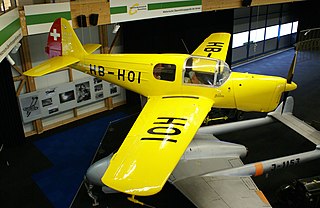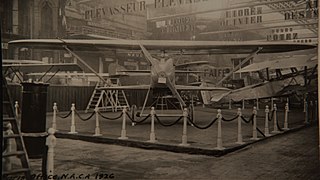
The Comte AC-4 Gentleman is a 1920s Swiss two-seat sport/training aircraft produced by Flugzeugbau A. Comte.

The DINFIA IA 45 Querandi was a 1950s Argentine twin-engined light transport aircraft built by the DINFIA.

The DFW Mars was an early German military utility aircraft built in 1913, the first original design manufactured by Deutsche Flugzeug-Werke (DFW). The aircraft was produced in both monoplane and biplane versions, which shared a common fuselage and empennage. The monoplane version featured wings that were wire-braced to a kingpost on the forward fuselage, and was powered by a 71 kW (90 hp) NAG engine. Examples of the monoplane built as dedicated trainer aircraft also incorporated a reinforcing truss beneath the wings. The biplane had conventional three-bay wings of unequal span and was powered by a 75 kW (100 hp) Mercedes engine. The wings of both the monoplane and biplane versions featured prominent sweepback.

The DFW R.II was a German bomber aircraft of World War I. It was developed at a request by the Luftstreitkräfte in spring 1917 after their experience with the R.I had been generally positive, but only two were ever built despite six being ordered.

The Farman F.430 was a 1930s French light transport designed and built by the Farman Aviation Works. Two variants with different engines were known as the F.431 and F.432.

The Nardi FN.305 was an Italian fighter trainer and liaison monoplane developed by the Fratelli Nardi company.

The Nord 1200 Norécrin is a French two or three-seat cabin monoplane designed and built by Nord Aviation.

The Gotha LD.1 and its derivatives were a family of military aircraft produced in Germany just before and during the early part of World War I. Used for training and reconnaissance, they were conventional designs with two-bay unstaggered wings, tailskid landing gear, and two open cockpits in tandem. Made quickly obsolete by the rapid advances in aviation technology, several were supplied as military aid to the Ottoman Empire when withdrawn from German service.

The LVG B.I was a 1910s German two-seat reconnaissance biplane designed by Luft-Verkehrs-Gesellschaft for the Luftstreitkräfte.

The Avia 156 was a 1930s Czechoslovakian six-passenger commercial transport airliner for both mail and passengers, designed by Robert Nebesář and built by Avia. The type performed well but only one was built.

The Bernard SIMB AB 14 was a 1920s French single-seat sesquiplane fighter aircraft designed and built by the Société Industrielle des Métaux et du Bois (SIMB). With a reluctance of the French authorities to purchase monoplanes the Bernard 14 was designed as a sesquiplane with Y-form struts bracing the wings on each side. It was powered by a Hispano-Suiza 12Hb inline piston engine and had a fixed tailskid landing gear. While on a test flight on 22 February 1926 the aircraft suffered a catastrophic structural failure of the upper wing and the only Bernard 14 was destroyed.
The Caudron C.480 Frégate was a French three-seat touring monoplane designed by Maurice Devlieger and built by Société des avions Caudron.

The Bernard 15 C1 or Bernard SIMB AB 15 was a 1920s French single-seat sesquiplane fighter aircraft designed and built by the Société Industrielle des Métaux et du Bois (SIMB). With the structural failure of the earlier Bernard 14 the Bernard 15 was an improved variant with a greater span upper wing. It was powered by a Hispano-Suiza 12Hb inline piston engine and had a fixed tailskid landing gear. The performance was not an improvement on the Bernard SIMB AB 14 and only the prototype was built.

The Comte AC-12 Moskito was a 1930s Swiss three-seat light touring cabin monoplane produced by Flugzeugbau A. Comte.
The Yatsenko I-28 was a 1930s Soviet single-seat fighter designed by Vladmir Yatsenko and first flown in 1939. The I-28 was a low-wing cantilever monoplane of mixed construction powered by a 900 hp (671 kW) Tumansky M-87 radial piston engine. It had an enclosed single-seat cockpit with a rearwards sliding canopy. The wing had an inverted-gull shape to reduce the length of the retractable main landing legs. The prototype was destroyed shortly after the first flight but an order was placed for 30 production aircraft. Also ordered was a prototype of an attack version, the I-28Sh. Although the first five production aircraft were completed the programme was cancelled in early 1940.

The Bernard 82 was a French single-engined long-range monoplane bomber designed and built by Société des Avions Bernard. Only two prototypes were built and the type did not enter production.

The Aviméta 132 was a French three-engined monoplane transport for eight-passengers designed and built by Aviméta. It was the first French all-metal aircraft but only one aircraft was built.

In October 1917 Nieuport began construction of a prototype monoplane fighter known as the Nieuport Madon, a strut braced monoplane.
The DFW D.I was a German fighter aircraft produced during World War I.
The LVG D.IV was a German fighter plane built by LVG in World War I.

















